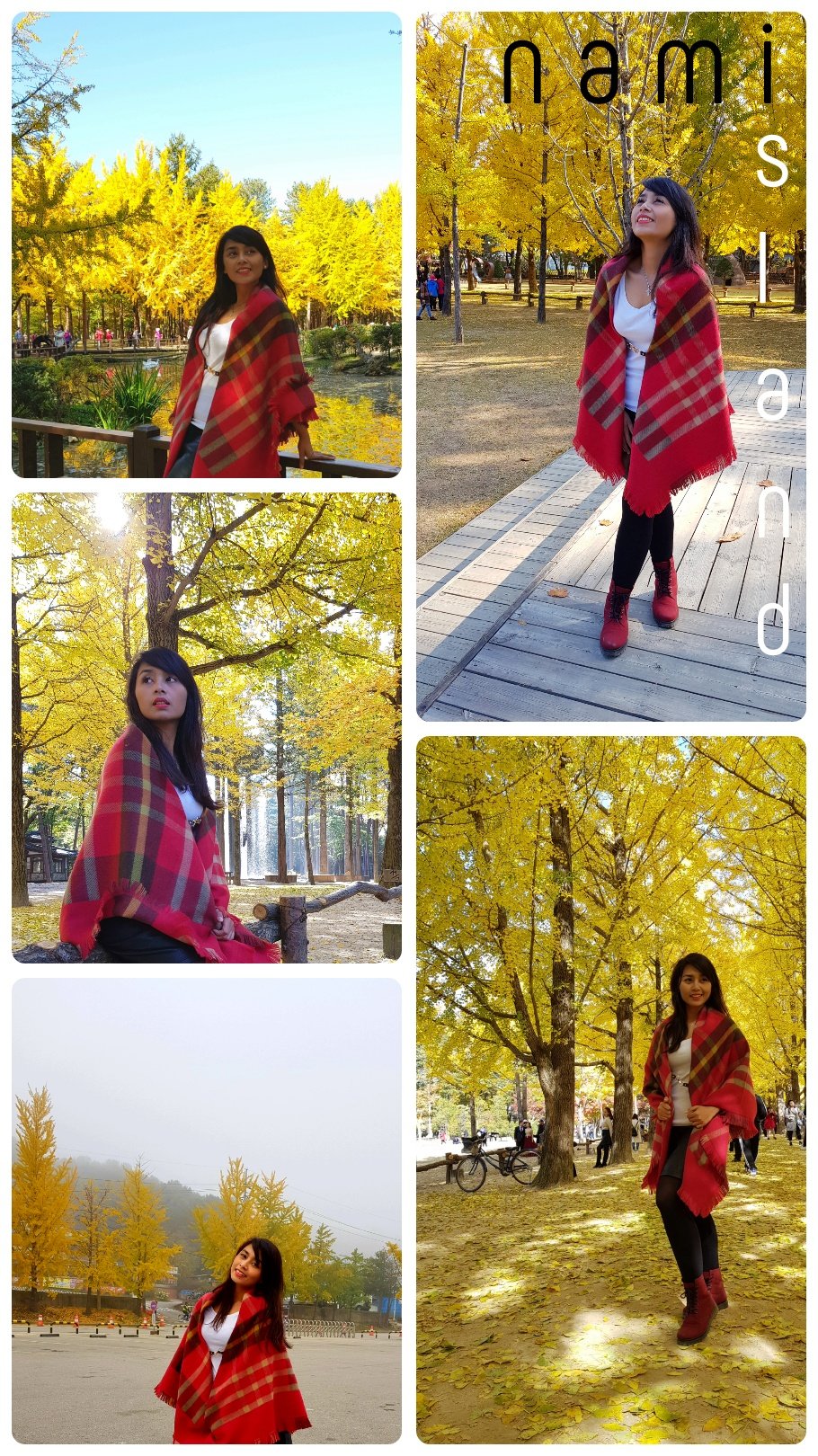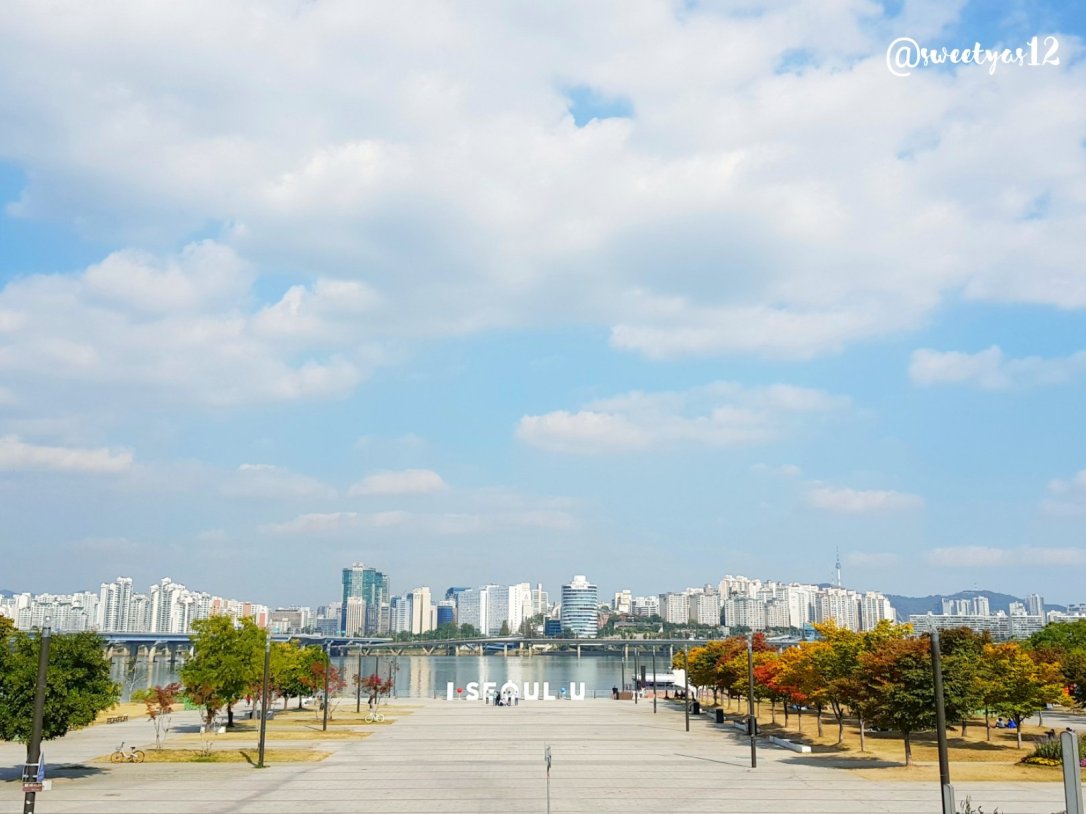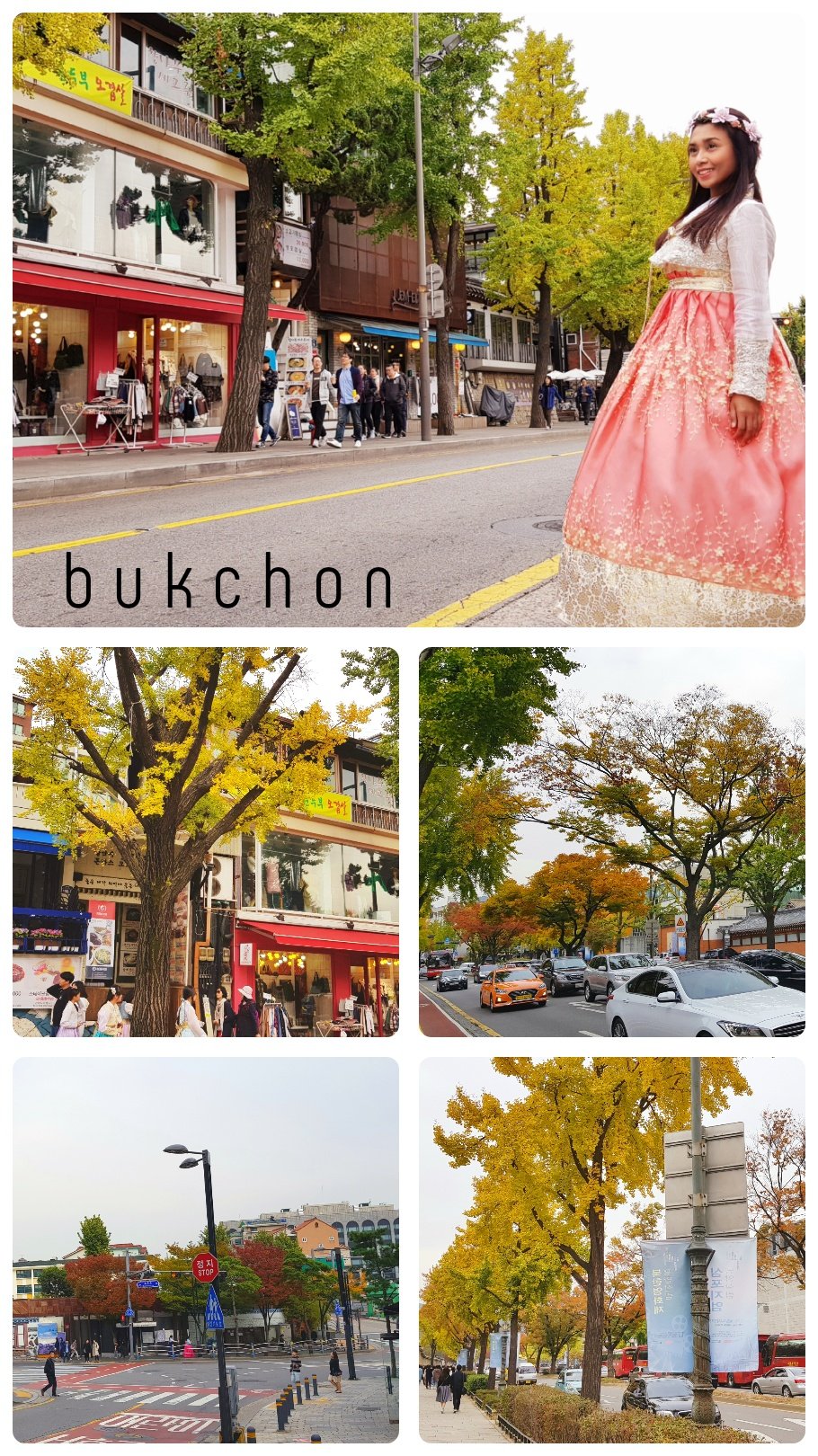There are so many reasons to fall in love with Seoul when it’s in autumn. Humid air, cool weather, low penetration of sunlight, and colorful trees are the things I love the most about autumn. Maple trees, ginkgo trees, and any other trees formed a beautiful red-yellow-gold canopy. This kind of view can be found almost in every corner of Seoul. When in Seoul, I spent several days to look for autumn colors.
1. NAMI ISLAND
Situated 63 km from Seoul, in the middle of the Han River, Nami Island looks like half moon. Others say it looks like a leaf floating gracefully on top of Cheongpyeong Lake from above. Formed with pebbles and sand, there are no mountains in the island, but there are trees tall enough to touch the sky.
When spring comes, Nami Island is covered in flowers. In summertime, the wind blows through the shady woods. In autumn, the gold and red leaves covered the trees then fall to the ground. While in winter the island is transformed into a world of icicles and snow. This 460.000 square meter island, embroided with breathtaking gardens and woods, is where the walking paths greet the sunrise and sunset. These are the most beautiful gifts that Nami Island gives to its visitors.
Years ago Nami Island declared its cultural independence and became Naminara Republic. Of course, it’s a imaginary nation and its export is just fairy tale. Today Nami Island is a place for rest and relaxation. Human beings, animals, and trees share harmony far away from crowds and civilization.
There are there ponds in the island, such as Eco Farm Yeonryeonji Pond, Jeonggwan Baekryeonji Pond, and Yuyeongi Pond. If yoh want to relax and just do some sightseeing activities, you can go to Bungalow Row Riverside Path, Changgyeongwon Garden, Iseul Recycling Garden, Dodamsambong Garden, Baekpungmilwon Maple Garden. Parents with kids can enjoy pool facility at Water Garden Swimming Pool.
In autumn, most people come to Naminara just to see this picturesque place and capture the beautiful scenery of autumn colors. The famous place to take autumn colors in Naminara is Ginkgo Tree Lane. If you want to have clear view of this lane, come early in the morning. Starting from 09.00, Ginkgo Tree Lane will be flooded by people. There are other tree lanes in Naminara; Metasequia Lane, The Maple Lane of True Love, Central Korean Pine Tree Lane, Chinese Platycarya Lane, Cherry Tree Lane, Cornel Tree Lane, Red Woods Lane, Tulip Tree Lane, White Birch Lane, and many more.
2. THE GARDEN OF MORNING CALM
We continued our journey to The Garden of Morning Calm by Gapyeong Tour Bus. This place is about 60 minutes bus ride from Nami Island. Morning Calm is a superhuge garden which consists of several theme gardens, such as western garden, Japanese garden, Sukgeun garden, etc. The Garden of Morning Calm, a 30,000 meter-square garden, is open year-round and is a great spot to visit for families, couples, and photographers alike.
Scenic walkways, beautifully manicured grass, and flower beds connect the garden’s different themed sections. The Sukgeun Garden is shaped like the Korean Peninsula and is carpeted with beautiful flowers on both sides representing the desire for South and North Korea to be reunited. It is easily one of the most popular and meaningful attractions at the garden.
In my opinion, this garden is so much better and more beautiful than Nami Island. I could stay there as long as I want, admire all the stunning flowers and trees there. You will never get enough of this place. In autumn, the ginko trees turned to yellow perfectly and other trees became red. The flowers also bloomed stunningly there just as in Spring season.
How to go to Gapyeong county :
- In my experience, I used ITX – Express train. ITX is a train which connects Seoul and nearby area. The starting point in Seoul is Yongsan Station, but it will make a quick stop at Ichon Station and Cheongnyangni Station. With this express train, it will carry you to Gapyeong Station in 45 minutes (while the regular ITX train will take approximately one and a half hours to get there).
- In front of Gapyeong Station, there is a bus shuttle for Gapyeong Tour Bus. From this spot, I started the tour around Gapyeong.
- If you plan to visit The Garden of Morning Calm, you can go back to Seoul from Cheongpyeong Station.
3. DEOKSUGUNG PALACE
Inside the palace (Deoksugung), the autumn atmosphere is felt more vivid. This palace was originally built during the Joseon period. This historic palace played an important role in Korea’s modern and contemporary history. In fact, it served as the backdrop for the Great Korean Empire (Daehanjeguk). Deoksugung is the only palace among all the ancient palaces in Seoul to have a Western-style garden, fountain, and modern royal palace, it stands as the bridge as rhe bridge between the older and modern eras.
Inside the palace (Deoksugung), the autumn atmosphere is felt more intense. This palace was originally built during the Joseon period. This historic palace played an important role in Korea’s modern and contemporary history. In fact, it served as the backdrop for the Great Korean Empire (Daehanjeguk). Deoksugung is the only palace among all the ancient palaces in Seoul to have a Western-style garden, fountain, and modern royal palace, it stands as the bridge as the bridge between the older and modern eras.
4. DEOKSUGUNG DOLDAM-GIL ROAD
The three-lined road that follows the southern stone wall of Deoksugung Palace , so-called Deoksugung Doldam-gil, is one of Seoul’s most romantic autumn walks. Deoksugung Doldam-gik stone-wall road has been designated one of Korea’s 100 most beautiful roads. A beautiful for a stroll with tall trees lining the street and ancient stone walll. The trees along the road form a canopy that blazes in all hues of red, orange, and gold. In the late autumn, the fallen leaves blowing in the wind provide just right amount of autumnal melancholy.
How to get to Deoksugung & Doldam-gil Road :
- Take subway line 1 or 2 then get off at City Hall Station exit 2 or 12). The ticket price is KRW 1.000 (it’s closed in Tuesday). Permanent events (the changing guards ceremony) are held at 11.00, 14.00, and 15.30.
5. EWHA WOMEN UNIVERSITY
Ewha campus offers a pleasant learning environment. Ewha campus is built on a hill, with flower gardens around it. I could imagine my self lying on the garden while reading a textbook after finishing my class. Or I could set a picnic with my friends in the garden. Ewha campus is really a picturesque place.
There is a fashion street near Ewha which connects Ewha Woman’s University and Ewha Station. Ewha Woman’s University has been a hot shopping spot leading the fashion trends of Seoul and giving birth to the term “Idae Style” in the 1990s before “Gangnam Style” came out. Clothes, accesories, beauty parlors, and more can be found in this shopping area, which is popular with young women. Lost of fascinating small shops are clustered along a side street that branches off from the main street. It is a perfect spot to shop for low to mid-priced cosmetics.
How to get to Ewha Woman’s University
- Take exit no. 2 or 3 of Ewha Woman’s University Station (line 2). Go straight on along the fashion street, then you will arrive in front of Ewha Campus.
6. GYEONGBOKGUNG PALACE
Gyeongbokgung Palace was the first royal palace built un the Joseon Dynasty and where the Joseon Dynasty’s 500-year history began. Gyeongbokgung Palace, whose literal meaning is “wish for your blessing and prosperity”, is the largest and the most majestic of the five ancient palaces that remains in Seoul today. It was founded in 1395. What you see today, however, largely dates from a 19th century reconstruction.
Gyeongbokgung provides a glimpse into Joseon’s royal culture and architecture through the Geunjeongjeon and other structures. The National Folk Museum of Korea and the National Palace Museum are also located on the palace ground.
Highlights of the palace including the imposing throne hall (Geunjeongjeon) , a royal banquette pavilion (Gyeonghoeru) surrounded by a square pond, a pleasure pavilion (Hyangwonjeong) surrounded by a reflecting pond with reflections of not only the pavilion itself, but the surrounding mountains as well. The palace gardens are filled with maples, pines, and ginkgoes, so it’s quite a colorful place to stroll about in autumn, especially when the sky is blue.
How to go to Gyeongbokgung Palace
- Take train on line 3 and get off at Gyeongbokgung Station (exit 5). Ticket price’s KRW 3.000. It’s closed on Tuesday. The changing guards ceremony is held 3 times a day (10.00, 13.00, and 15.00).
7. GAROSU-GIL, SINSADONG
When in Seoul, I got curious about where the upscale people hang out is. One of the most favorite place for upscale people of Seoul is in Garosu-gil, Sinsadong. In Sinsa-dong, you will find unique apparel and accessories from Korea’s most promising young designers along this two-lane road lined with ginkgo trees that runs from Sinsa-dong to Apgeujong-dong. Large shops with multiple foreign brands give shoppers the chance to take in fashion trends from all over the world.
How to get to Garuso-gil :
- Take subway, get off at Sinsa Station (line 3) exit 8. Just gi straight on until you find the sign of Garosu-gil, then turn left.
8. N SEOUL TOWER / NAMSAN MOUNTAIN
Korean love autumn so much. Korean love hiking to the mountains in the autumn. For Korean, going to the mountains in autumn means to be thankful for the blessings received by Korea in that year. The thing that amazes me is not only young people who do hiking, but also the elderly. The typical autumn scenery on the hills and mountains is indeed very beautiful. Yellow and red colors cover the hills and mountains.
Namsan Mountain is one of the most favorite destinations among Korean. When in autumn, it’s flooded not only by foreign people but also locals. In the top of the mountain, there is Namsan Tower (it’s famous as N-Seoul Tower). Many things can be done in the N-Seoul Tower area. You can visit observatory desk on the top of the tower, put your name and your lover’s name on the love lock, drink coffee in the coffeeshops there. Or you can simply enjoy the moment under a tree to admire how beautiful autumn color is (that was what I did when I visited Namsan Tower).
How to get to Namsan Tower :
- From exit 3 Myeongdong Station, turn left and walk through the alley and stay to your right. You will see Hotel Pacific, stick to your right and walk through the alley beside Hotel Pacific. Namsan Cable Car Station is at the top of the hill near the Chinese Consulate.
9. YEOUIDO HANGANG PARK
Yeouido is often called Seoul’s Manhattan. The true gem of Yeouido is the Hangang (river) rather than the buildings. If you take a ferry cruise and sail on the river, you can view the bridges on the Hangang that have undergone many changes over the course of Korean history. Hangang is still the iconic foundation upon which the culture of Seoul blooms. In spring and autumn, Hangang Park transforms itself into a stage for various festivals. Other popular attractions along the banks of Hangang include the ” I SEOUL U” sign, public swimming pools that cool down the hot summer weather, and many more.
When I visited Yeouido Hangang Park in October 2017, the colors of the leaves had matched the autumn colors. So many red leaves there in the park. There were many teenagers who took a break in the park. They set picnic together with friends. Some of them set up tents on the ground, not for staying overnight, just to relax at afternoon time. Another group of teenagers rode tandem bikes around the park. As for me and my husband, we sat on the bench, watched people having a great time there, and enjoyed the autumn breeze there.
How to go to Yeouido Hangang Park (“I SEOUL U” Sign) :
- Yeouinaru Station (line 5), exit 2.
10. BUKCHON AND NEARBY
Bukchon is well-known as home of Korean traditional houses is Seoul. If we walk around Bukchon-ro (Bukchon Road) and Samcheong-dong is autumn, we can see how beautiful those areas are with maple leaves and ginkgo leaves turn into red and yellow. Just strolling along that area and find yourself immersed in the good vibes of autumn.
How to get to Bukchon Hanok Village:
- Take train in line 3 (orange line) then get off at Anguk Station. Take exit 2 or 3 then walk for about 1 km to reach Bukchon Hanok Village.










